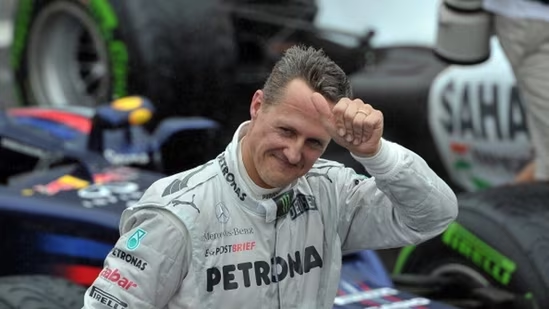Revisiting the legend of Michael Schumacher
Over the past few years, Michael Schumacher has often been a reference point to evaluate reigning Formula 1 world champion Lewis Hamilton. Driving his standout black Mercedes, the 36-year-old has been rewriting history, breaking records that once belonged to the Ferrari giant.  PREMIUM
PREMIUM
In a long battle with brain injury following a skiing accident in 2013, the German’s legendary career and life is being revisited following the September release of the biographical documentary, 30 years after his sensational debut at the 1991 Belgian Grand Prix at Spa-Francorchamps.
Released on OTT platform Netflix, Schumacher takes us back further, to his early life in the 1980s and his immediate impact in F1, rise to stardom, struggle at Ferrari before finally becoming a motorsport legend and seven-time world champion who won 91 races in 19 seasons at F1 between 1991 and 2012.
The film also gives Schumacher fans an insight into the former F1 driver’s private life. Always known to be extremely protective about his personal space, Schumacher reveals a loving and caring family man who was often the soul of the party. It is an image quite at odds with the rapid, relentless and ruthless race-face inside that famous red crash helmet.
Through Corinna, his wife of 26 years, we also get a rare update on his condition. “Michael is here, different but here,” she says. “He still shows me how strong he is every day…“We’re together. We live together at home (on Lake Geneva, Switzerland). We do therapy. We do everything we can to make Michael better and to make sure he’s comfortable. And to simply make him feel our family, our bond. And no matter what, I will do everything I can. We all will. We’re trying to carry on as a family, the way Michael liked it and still does. And we are getting on with our lives.”
The movie uses archival material to show Schumacher, then a teenager from Kerpen, Germany, displaying exceptional skills and speed in karting. Back then Schumacher never thought of formula racing as competing in karts was his world. It was a pure mix of skill, talent, luck and chance that he got an opportunity to progress to single seaters in 1988, aged 19.
Extraordinary luck was responsible for his entry into Formula 1. Schumacher was driving sports cars in 1991 and was nowhere close to formula racing - apart from one isolated race in Japanese Formula 3000. But Jordan driver Bertrand Gachot was given a two-month prison sentence in England for fighting with a taxi driver following which the Irish team suddenly needed a replacement.
In came a lean and dreamy eyed 22-year-old German named Schumacher and took the F1 world by storm by qualifying seventh on debut in an average car. Such was his impact that he was instantaneously signed by Benetton - then the fourth best team on the grid - for the next race in Italy where the German finished a brilliant fifth, earning his first points in F1 and thereby starting a journey in a world he would go on to dominate.
When Schumacher entered Formula 1, the sport was dominated by Ayrton Senna, Alain Prost, Nelson Piquet and Nigel Mansell, each one a world champion. These names were forced to take notice of the young German at Benetton who was reaching the rostrum regularly and won his first race at the circuit where he had debuted exactly a year ago.
In quick time, Schumacher had established himself as the next big thing, finishing third and fourth in his second and third seasons in F1 with two race wins and multiple podiums.
Schumacher joined the big league when he went on to claim the world championship in 1994. With the retirement of Prost, Mansell, Piquet and the unfortunate death of Senna at the 1994 San Marino Grand Prix, this period proved to be the turning point for Schumacher. At 25, he became the most significant name in the sport by winning the world championship in only his fourth F1 season. By the end of 1995, he had become a double world champion.
In 1996, the two-time world champion, the hottest property in F1, signed for Scuderia Ferrari ignoring offers from other top teams. The 112-minute film spends a lot of time on the German’s tenure at Ferrari from 1996 to 1999.
Being at the oldest, most successful team in the sport with millions of fans across the globe is a matter of honour. One which comes with its own weight of expectations - anything less than a win is a failure for the Scuderia.
In 1996, Ferrari had gone 17 years without a drivers’ world title since Jody Scheckter winning in rosso corsa (racing red) way back in 1979. Gilles Villeneuve, Prost, Mansell had all tried but failed to deliver the title at Ferrari.
Schumacher understood the burden of his new job: failure would drive him to obscurity. But winning in the red car would make him much more than any other world champion.
He started building a team of the best engineers and mechanics. But Ferrari back then were far from having the best car. To win in F1, you don’t just need the best driver, you also need the best car. “That car was a disaster,” says Eddie Irvine, Schumacher’s Ferrari teammate from 1996 to 1999, in the movie.
Despite a very average machine, Schumacher won three races in his first season with Ferrari. “To win races in that car was the greatest achievements of any driver. It is beyond credibility how that happened,” says Irvine.
The first of those three victories came at the Spanish GP which is regarded as one of Schumacher’s finest. Starting third and falling back after a clutch issue at the start, Schumacher pierced through the field in torrential rain, overtaking eventual champions Williams to win his first race for Ferrari.
What Schumacher displayed that Sunday was immaculate race craft, earning him the nickname ‘regenmeister’ (rain master). He finished an unbelievable 45 seconds ahead of second placed Jean Alesi and had lapped every car apart from the ones on the podium. “Perfection. I am just the type of person I couldn’t live with anything lower,” Schumacher says, in an old interview used in the movie.
Schumacher finished third in the 1996 championship behind Williams’ Damon Hill and Jacques Villeneuve with 59 points. His teammate Irvine had only 11 points, going on to show how Schumacher’s uncompromising speed pushed the inferior Ferrari all year long.
For the next two years, Schumacher and Ferrari’s title bid fell short to Williams’ Villeneuve and Mika Hakkinen of McLaren. Despite a promising start in 1999, Schumacher’s bid for the title ended with an accident at the British Grand Prix when he crashed at Stowe due to failed brakes, breaking his leg.
Out for three months, he made a spectacular return at the penultimate race of the season in Malaysia taking pole, qualifying almost a second faster than Irvine.
But four years had passed and the hope that Schumacher would finally deliver the drivers' title for Ferrari was beginning to dwindle. People were now questioning if the then two-time world champion was the right man for Ferrari.
Schumacher's on-track controversies also didn't help. Often his commitment and the burning desire to win made him overstep the mark, earning the wrath of the fans and authorities alike. Almost always, Schumacher was convinced that he had done no wrong.
He had controversially clashed with Damon Hill at the season-ending 1994 Australian GP which put both out of the race, handing the championship to Schumacher by one point. His crash into Villeneuve at the season ending 1997 European GP not just put Schumacher out of the race but also led to an unprecedented disqualification from the entire season by the international automobile federation (FIA).
But in 2000 Schumacher fought Hakkinen, the McLaren team, criticism and self-doubts to finally win. It was his third and Ferrari’s first drivers’ title in 21 years.
Having delivered the title to Ferrari, Schumacher had nothing else left to prove. The film focuses little on Schumacher’s five consecutive titles at Ferrari possibly because everyone knows about it. That famous era eventually came to be known as the golden period for Schumacher and Ferrari when they won an unprecedented five consecutive world titles from 2000 to 2004, smashing every record that existed. It was the time when Schumacher transformed into a legend, the red baron who would go past Juan Manuel Fangio, the sport’s godfather who won five world titles in the 1950s.
Experience unrestricted digital access with HT Premium
Explore amazing offers on HT + Economist Start 14 Days Free Trial Already Subscribed? Sign In
Disclaimer: The copyright of this article belongs to the original author. Reposting this article is solely for the purpose of information dissemination and does not constitute any investment advice. If there is any infringement, please contact us immediately. We will make corrections or deletions as necessary. Thank you.







